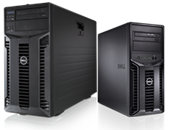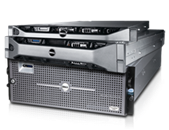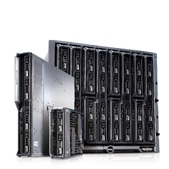Businesses use servers to centrally host various applications such as email, collaboration, firewall, file and print in a secure manner. In this article, I will go over the server market, vendors, technologies and categories of product offerings.
Potential – To start with the market potential, worldwide server TAM is estimated to be roughly $54B in 2014. YoY growth is forecasted to be around 1.5%, as companies perform their cyclical IT infrastructure refresh, post the slowdown during the financial crisis. Servers come in various price bands starting from few ‘000 $s to a couple of million $s. Demand for servers in the public cloud is expected to be the primary driver for server market growth, while server consolidation and virtualization is foreseen to dampen unit demand. Modular servers – blade and density-optimized servers – represent distinct segments of growth for vendors in an otherwise mature market.
Unit shipments are expected to grow by 5.5% in CY14, with higher volumes from lower price bands. To get a better perspective of the size of server market, let us compare it with overall IT spending. Gartner has projected worldwide IT spending of $143B for data center systems, and $320B for Enterprise software during the year. Servers thus account for nearly 38% of the IT systems spend, and a little over 11% of the combined HW & SW IT spending.
Demand drivers – Strategic focus by enterprises on data center and server consolidation, with latter driven by virtualization technologies, and adoption of SMAC (social, mobile, analytics and cloud) applications are among the key trends that will determine demand for various form factors and types of servers. SaaS providers such as Facebook, Google and Baidu, and additionally service providers are seen driving growth, especially for hyper-scale servers.
Server generations – The 1st generation of servers was largely based on mainframes and terminals, while the 2nd generation has been driven by the client/server model in the PC era, which uses LAN and Internet technologies for communication. The 3rd generation of servers is instead built on a foundation of SMAC technologies, with exploding number of connected users and apps which demand hyper-scale processing capability.
Vendors – Over the years, IBM, HP and Dell have been the dominant players in the server market, with offerings for all types of servers – blade, density-optimized, rack and tower servers. Cisco, which had earlier partnered with these firms to sell its storage and networking products to Enterprise data centers, entered the server business by launching its blade server product line in 2009. The current pecking order of players by market share is HP, IBM, Dell, Oracle and Cisco.
HP holds the number 1 position in the worldwide server market with over 25% revenue share, followed by IBM with nearly 24% share, Dell at roughly 17%, and Oracle and Cisco a little lower than 6% each. IBM which was seen to dominate to server market with over 35% market share in 2012, has not only dropped revenue share, but also announced its plan to offload low margin x86 hardware business to Lenovo. It will continue to play in this market with high margin System-z and non-x86 servers. Sales through ODMs such as Quanta and Inventec represented nearly 7% of overall server revenue. Majority of these sales were in the US market and primarily to Google, Amazon, Facebook and Rackspace.
Geography – US is the largest market for servers with nearly 39% of worldwide server TAM, followed by EMEA region with 22% and APEJ with 20%.
Server architectures – X86-based platforms have been the predominant architectural choice as it allows enterprises to run their non-mission critical applications at affordable price points. Non-x86 technologies such as RISC, CISC and EPIC were typically chosen for mission-critical applications and databases including ERP, CRM, data warehouses, business intelligence and analytics, where key considerations are reliability, availability and serviceability (RAS). The value proposition gap between non-86 and x86 servers has been shrinking due to advancement in x86 capacity and performance capabilities, and emergence of highly sophisticated x86 virtualization mechanisms. And so, the market for non-x86 technologies at high price points has been rapidly declining.
Market share by architecture – X86 servers account for over 78% of total server revenue. HP leads x86 market with nearly 30% market share, while Dell is next with 21% market share. Non-x86, the declining market segment, is led by IBM with nearly 70% market share. IBM controls most of CISC server market, and HP dominates EPIC server segment. IBM and Oracle are major players in RISC market, with IBM being the dominant player with 71% market share.
Product categories – Apart from technology, server offerings are also distinguished by form factor and are available as tower, rack, blade and density-optimized servers.
A tower server is a floor-standing unit with integrated processors, memory, I/O controllers and peripherals. These entry level server offerings are typically seen in SMBs which have no delineated lab space or data center facility, and are opted for when low cost is a priority, and there are limited scalability and network/storage connectivity requirements. The footprint usage of these units is limited.
Figure 1 – Tower server form factor
A rack-mounted server, as the name indicates, fits into 19” wide rack units. These servers come in heights that are multiples of ‘U’s, each U being 1.75”. These are used when each node is of fairly large capacity; overall server configuration consists of considerable number of nodes, and when scalability is important. The footprint usage of this type of servers is moderate. These help address fluctuating workload challenges through a varying balance of processing, memory, I/O and internal storage resources. These servers are plugged into a rack and then power, networking and storage equipment are connected.
Figure 2 – Rack-mounted server form factor
A blade server is a modular solution that slides into a chassis slot, and typically houses processors, memory, local hard disk storage, network connections and storage connections. Apart from servers, the enclosure would also house blades for network, storage and power. These are used when each node has to be reasonably small capacity; overall server configuration consists of considerable number of nodes, and when scalability is important. Blade systems are advantageous in that they are simple to setup and manage, and have a small footprint.
Figure 3 – Blade Server form factor
Blade servers form a primary building block for integrated systems in the datacenter, as enterprise customers evolve toward private clouds. Converged blade platform, with a compelling value proposition of reduced IT complexity, is an opportunity for pull-through revenue for storage, networking, software and services, beyond the servers. Blade servers form a growing segment and form a key element in the DC vendor’s portfolio for both revenue and profitability.
Density-optimized servers are a hybrid of blade and rack servers where multiple server nodes are available in 2U or 4U rack chassis, and are targeted for high performance computing and cloud applications, and typically in use by hosting companies. Density-optimized servers are utilized by large homogeneous hyper-scale datacenters to leverage scalability and efficiency of this form factor.
Figure 4 – Density-optimized form factor
Market split by form factor – Tower, rack, blade and density-optimized servers represent 14%, 59%, 14% and 13% of x86 units there were shipped in CY13. Blade server market is led by HP with 42% market share worldwide, followed by Cisco with 25% share and IBM with nearly 14% share.
Future action is in modular servers, namely blade and density-optimized servers, though they currently form only 17% and 6% respectively of total server revenue. Virtualization and SMAC adoption will continue to be key drivers for server demand across the globe. A converged server/storage/network offering is essential to fully tap into the business potential in data centers, in the era of Fast IT.



